Restoring Balance to the Major Fascial Structures in the Body
IVM
2 Day Workshop – 14 CE Hours
Visceral Manipulation is a very powerful and practical modality to learn. It is easy on your body and integrates well with other therapies.Visceral Manipulation was developed by French Osteopath and Physiotherapist, Jean-Pierre Barral. When the body is at optimal health, the relationship between the organs (viscera) and structures of the body (muscles, membranes, fasciae and bones) remains stable despite the body’s endless varieties of motion. However, when one organ can’t move in harmony with its surrounding viscera due to abnormal tone, adhesions or displacement, it works against all the body’s organs and structures. This disharmony can create fixed, abnormal points of tension that the body must move around. This can cause chronic irritation that, in turn, can pave the way for disease and dysfunction.Visceral Manipulation (VM) is a gentle hands-on therapy that works through the body’s visceral system (the heart, liver, intestines and other internal organs) to locate and alleviate abnormal points of tension throughout the body.Using Visceral Manipulation, therapists employ gentle manual forces that work to create normal mobility, tone and motion of the viscera and their connective tissues. Practitioners use the rhythmic motions of the visceral system to evaluate how abnormal forces interplay, overlap and affect the normal body forces at work. These gentle manipulations can potentially improve the functioning of individual organs, the systems the organs function within, and the structural integrity of the entire body.This introductory class provides a solid foundation in the basic techniques of Visceral Manipulation. Organ areas covered include abdominal sphincters, the liver, esophagus and stomach.Measurable learning outcomes include: identifying visceral restrictions and adhesions; defining the two forms of organ movement – mobility and motility; describing and performing the three visceral release techniques – induction & following, stretching and stacking; palpating, evaluating and releasing the sphincter of odi, cardiac sphincter, pylorus and the iliocecal valve; identifying the location and visceral connections of the esophagus, liver and stomach; performing a mobilization of the stomach and liver; performing an esophageal stretch.
PREREQUISITE
There are no prerequisites. This class is open to anyone who would like to learn this technique
REQUIRED TEXT
"Anatomy Trains" by Thomas Myers
CONTINUING EDUCATION CREDIT
This seminar is approved by the National Certification Board for Therapeutic Massage and Bodyworkers (NCBTMB) for 8 continuing education credits. NCBTMB #450308-06

